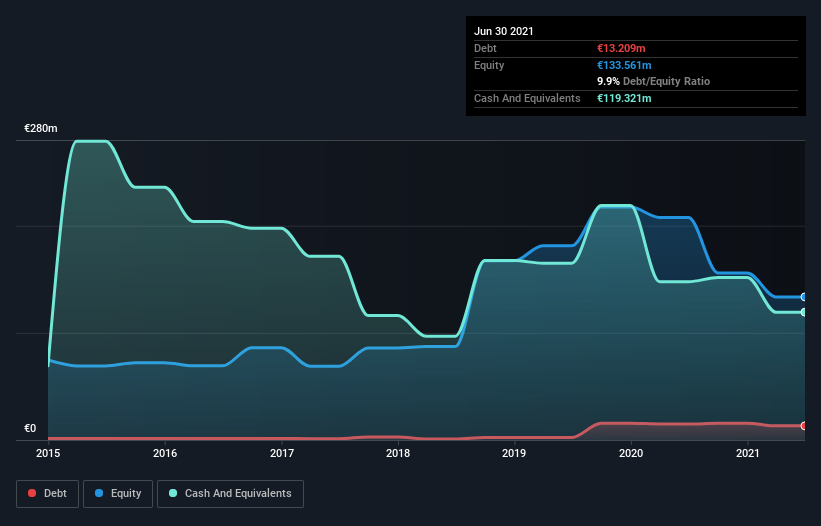
Some say volatility, rather than debt, is the best way to think about risk as an investor, but Warren Buffett famously said that 'Volatility is far from synonymous with risk.' So it might be obvious that you need to consider debt, when you think about how risky any given stock is, because too much debt can sink a company. Importantly, Innate Pharma S.A. (EPA:IPH) does carry debt. But the more important question is: how much risk is that debt creating?
Why Does Debt Bring Risk?
Debt assists a business until the business has trouble paying it off, either with new capital or with free cash flow. In the worst case scenario, a company can go bankrupt if it cannot pay its creditors. However, a more usual (but still expensive) situation is where a company must dilute shareholders at a cheap share price simply to get debt under control. By replacing dilution, though, debt can be an extremely good tool for businesses that need capital to invest in growth at high rates of return. When we think about a company's use of debt, we first look at cash and debt together.
See our latest analysis for Innate Pharma
How Much Debt Does Innate Pharma Carry?
As you can see below, Innate Pharma had €13.2m of debt at June 2021, down from €15.0m a year prior. However, it does have €119.3m in cash offsetting this, leading to net cash of €106.1m.

How Healthy Is Innate Pharma's Balance Sheet?
We can see from the most recent balance sheet that Innate Pharma had liabilities of €42.6m falling due within a year, and liabilities of €90.0m due beyond that. Offsetting this, it had €119.3m in cash and €3.60m in receivables that were due within 12 months. So its liabilities total €9.74m more than the combination of its cash and short-term receivables.
Of course, Innate Pharma has a market capitalization of €358.0m, so these liabilities are probably manageable. But there are sufficient liabilities that we would certainly recommend shareholders continue to monitor the balance sheet, going forward. Despite its noteworthy liabilities, Innate Pharma boasts net cash, so it's fair to say it does not have a heavy debt load! When analysing debt levels, the balance sheet is the obvious place to start. But it is future earnings, more than anything, that will determine Innate Pharma's ability to maintain a healthy balance sheet going forward. So if you're focused on the future you can check out this free report showing analyst profit forecasts.
Over 12 months, Innate Pharma made a loss at the EBIT level, and saw its revenue drop to €49m, which is a fall of 22%. That makes us nervous, to say the least.
So How Risky Is Innate Pharma?
By their very nature companies that are losing money are more risky than those with a long history of profitability. And the fact is that over the last twelve months Innate Pharma lost money at the earnings before interest and tax (EBIT) line. Indeed, in that time it burnt through €27m of cash and made a loss of €77m. But the saving grace is the €106.1m on the balance sheet. That kitty means the company can keep spending for growth for at least two years, at current rates. Summing up, we're a little skeptical of this one, as it seems fairly risky in the absence of free cashflow. There's no doubt that we learn most about debt from the balance sheet. However, not all investment risk resides within the balance sheet - far from it. Case in point: We've spotted 2 warning signs for Innate Pharma you should be aware of.
At the end of the day, it's often better to focus on companies that are free from net debt. You can access our special list of such companies (all with a track record of profit growth). It's free.
New: AI Stock Screener & Alerts
Our new AI Stock Screener scans the market every day to uncover opportunities.
• Dividend Powerhouses (3%+ Yield)
• Undervalued Small Caps with Insider Buying
• High growth Tech and AI Companies
Or build your own from over 50 metrics.
This article by Simply Wall St is general in nature. We provide commentary based on historical data and analyst forecasts only using an unbiased methodology and our articles are not intended to be financial advice. It does not constitute a recommendation to buy or sell any stock, and does not take account of your objectives, or your financial situation. We aim to bring you long-term focused analysis driven by fundamental data. Note that our analysis may not factor in the latest price-sensitive company announcements or qualitative material. Simply Wall St has no position in any stocks mentioned.
Have feedback on this article? Concerned about the content? Get in touch with us directly. Alternatively, email editorial-team (at) simplywallst.com.
About ENXTPA:IPH
Innate Pharma
A biotechnology company, develops immunotherapies for cancer patients in France and internationally.
High growth potential with adequate balance sheet.


